Ease of Use
The Samsung WB5000 is commendably light and compact for a camera with such a big zoom lens, although its all-plastic construction doesn't feel as robust as rivals like the Panasonic FZ series or Olympus SP models. Still, what you lose in strength you gain in portability, with the WB5000 easily slipping unnoticed inside a small shoulder bag. That 24x optical zoom lens extends to provide a 26-624mm focal length, versatile enough for almost any photographic subject that you care to think of. There have been a number of recently announced models with 30x lenses, but in our view 24x is quite enough thank you, especially as it's often difficult to get sharp shots at the telephoto lens even despite being able to employ the effective built-in anti-shake system. The WB5000's 'Dual IS' mode offers both optical image stabilization and the ISO boosting digital variety, and in terms of light sensitivity there's a very respectable range stretching from ISO 64 up to ISO 6400. We'll of course be examining how well it does at its higher settings in the 'Image Quality' section of our review.
As expected, the WB5000's large lens dominates proceedings at the front of the camera. As the lens takes up the full height of the face plate, the small porthole-style window for the AF assist/self timer lamp is shifted over to the left out of harm's way. Above the lens is the built-in pop-up flash, activated by a button on the right of the lens barrel. The WB5000 has a fairly chunky handgrip that's covered in a textured rubber to aid handling, while there's a small thumb-rest on the rear coated in the same material. This combination makes the camera more comfortable to hold, and steadier too when shooting handheld at the extremities of the zoom.
Looking down on the WB5000's top plate we find the afore-mentioned flash, a shooting mode dial, small power button, and a rather spongy shutter button encircled by an equally unresponsive zoom lever. It's fair to say that I wasn't particularly enamoured with the performance of these two important controls. The WB5000 has a rather plasticky rocker switch for operating the zoom which takes around three seconds to travel from maximum wide angle to full telephoto - which is pretty quick for its focal range. We did find on occasion that said zoom took a moment or two to 'wake up' - and that its transitions are sound-tracked by a low mechanical blur; but it's low enough to avoid being off-putting.
Once you've zoomed in and got your composition how you want, with a half press of the shutter button the Samsung WB5000 is commendably swift to determine focus and exposure, the AF point highlighted in green and an operational 'beep' confirming you're good to go on and take the shot. With little noticeable shutter lag, at highest resolution setting a JPEG image is committed to memory in just under two seconds, the screen blanking out briefly, which isn't bad at all.
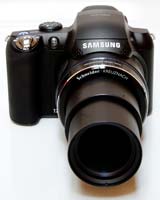 | 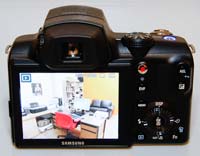 |
| Front | Rear |
The familiar bottle-top style dial which provides quick access to the shooting modes is much better, offering a positive action that clicks into place and stays there. This feels firm to the touch and well implemented, in that the user can't accidentally slip from one setting to the other. Ranged around the dial, we start with Samsung's own 'Smart Auto' mode. As it sounds, this is the manufacturer's equivalent of the intelligent auto modes on competitors from Panasonic (its Lumix range), Sony (the latest T-series Cyber-shots) and Canon (Digital IXUS family). Namely you point the WB5000 at a scene or subject that hopefully the camera recognizes, automatically adjusting its settings to deliver optimum results. This means that it's not necessary for the user to manually delve into scene modes to call up the likes of 'landscape' or 'flower'; the WB5000's operation is merely a case of point and shoot. Also of interest is the WB5000's Smart Face Recognition technology, which can learn up to 20 of your friends and family and automatically focus on them first, making sure that the most important subjects are always pin-sharp. In addition you can also browse more efficiently through your images by the people that you’ve registered with the camera.
Incidentally, as you turn the shooting dial, a virtual version with the same eight settings rotates in tandem on screen, highlighting and explaining each one as you select it. Continuing around the dial we discover the Movie mode (largely redundant given the one-touch movie button on the back). Although it hasn't got an 'HD' suffix in the model name, as indicated in our introduction the Samsung WB5000 nevertheless offers High Definition video clips, though at 1280x720 pixels rather than full HD 1920x1080. The adjacent setting on the dial is for video mode. You get the opportunity to either shoot at top resolution, a less memory hungry 640x480 pixels, or 320x240 pixels; choice dependant on intended use (whether playing back on an HDTV or merely posting on the Internet). Maximum frame rate at 1280x720 resolution is 30fps, with a reduced 15fps rate also selectable with a press of the button marked 'Fn' (or 'Function') on the camera back. Should users however plump for the very lowest picture quality, a faster frame rate of 60fps is selectable.
The full extent of the optical zoom is thankfully accessible when shooting movies, and there's also a very handy one-touch record button on the rear of the camera. The WB5000 offers stereo sound for better audio than competing models, while the H.264 format provides longer recording times. The only thing missing from the WB5000's comprehensive array of video options is the ability to pause recording mid-flow and then restart it, a useful function that's offered by several other Samsung compacts.
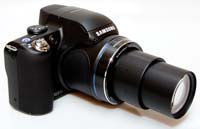 | 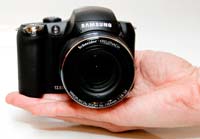 |
| Side | Front |
Next in line on the Mode dial is the dedicated Scene mode, with the various settings helpfully displayed on the LCD screen as icons with accompanying explanatory text. Along with 'Night', 'Portrait', 'Children' and 'Landscape' we get 'Text', 'Sunset', 'Dawn' and 'Backlight', with 11 choices in all. Samsung's 'Beauty Shot' mode is next, useful for both acne-d adolescents and those of us who have over-indulged by automatically retouching out spots and blemishes. The Night mode also finds its way onto the main dial, while the User1 and User2 allow you to customise the WB5000 to a certain extent by saving your key settings.
The final three modes will be of particular interest to more advanced users, with P (Program), A-S (Aperture / Shutter Priority) and Manual forming the creative heart of the WB5000. All three modes allow access to all of the WB5000's key features, while the A-S mode additionally allows you to set either the aperture or shutter speed, and M mode allows you to change both at the same time. The circular control wheel on the rear toggles between the Aperture and Shutter speed by pressing left and right, while spinning it round changes the values - an elegant solution on paper but one that only really works when holding the WB5000 at arm's length, rather than up to your eye. Still, the ability to select from an aperture range of f2.8 - 8 and shutter speeds of 1/2000th - 16 seconds is very welcome on this kind of camera.
Less welcome is the WB5000's shockingly bad RAW file implementation. One of the key attractions of this camera for pro shooters when it was first announced towards the end of 2009, in reality it turns out to a curse in disguise, rather than a blessing. The main problem is the glacial processing speeds, with the WB5000 taking over 10 seconds to save a single RAW image to memory, which means that you can only take advantage of all the benefits that RAW files have to offer if you're shooting non-moving or extremely patient subjects (and if you are very patient too). Selecting the RAW format also inexplicably limits the ISO range to 64-400, with 800-6400 only available for JPEG files, taking away one of the main advantages that RAW files offer. In short, if you're interested in the WB5000 mainly because of its RAW file support, start looking elsewhere now - this camera only really makes sense for JPEG shooters.
 |  |
| Pop-up Flash | Top |
The rear of the WB5000 is dominated by the large 3-inch LCD screen, which is the main way of composing your images for the majority of users. Disappointingly the screen has an average resolution of 230k dots - we've been rather spoiled by some recent competitors with higher-resolution screens. That said, we didn't have too many problems viewing the WB5000's screen in all but the brightest sunlight conditions.
The second way to compose your images is the electronic viewfinder, which juts out from the rear of the camera and helpfully offers dioptre control for glasses wearers. The EVF button on the rear toggles between this and the LCD screen. The EVF is a little small, grainy and murky, but it does helpfully display an array of shooting information and is useful in really bright conditions. As mentioned above, suing the control wheel to change the aperture / shutter speed is a little tricky while holding the WB5000 up to your eye, but certainly not impossible.
To the right of the LCD screen are the Movie Record and EVF buttons that we've previously discussed, and to the right of them are the small but none-the-less useful AEL (Auto Exposure Lock) and Exposure Compensation buttons, both of which are very useful for obtaining spot-on exposures. Directly underneath the EVF button is a small Menu button, which provides a range of selectable options, the brevity or otherwise of which is dependant on the particular mode the user is in. Let's assume, for example, we're shooting in Program mode. An icon illustrated vertical list provides access to four menus - Functions, Sound, Display and Settings. These include the ability to tweak operational sounds, LCD display, plus access to a setting menu, enabling memory to formatted or previously selected functions reset.
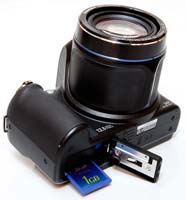 | 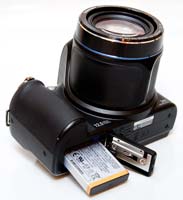 |
| Memory Card Slot | Battery Compartment |
Underneath the Menu button is a four-way directional control pad / control wheel with an OK button at its centre. This will be familiar to just about anyone who has ever used a digital compact before. It provides a means of selecting flash modes, self timer options, focus / macro mode or changing the on-screen display to show a nine zone compositional grid, all shooting information or just the very basics (i.e. simply the number of shots remaining). In the Manual focus mode the subject is helpfully enlarged and a horizontal distance scale is displayed to aid accurate focusing, although I still found it difficult to regularly achieve pin-point accuracy.
Below the control pad are two buttons. The obvious Play button also doubles up as a means of earmarking selected images for direct printing. The Function button allows quick access to some of the camera's key settings. As expected the amount of information and options accessed via a press of 'Fn' varies dependant on which shooting mode is selected. For example in regular auto mode the user merely has the ability to adjust image size and resolution. Twist the dial around to the program mode however and there's the ability to change the EV, choose metering modes, change from single shot to continuous capture, choose from the range of ISO settings, adjust white balance, set the photo style or turn the ubiquitous face detection mode on or off. Like its rivals, Samsung also allows user access to blink detection and smile shot in this mode. The Function button also handily doubles up as a delete button in playback mode.
There are two controls on the left hand side of the WB5000 (if viewing from the rear), where we find holes for the microphone and an included HDMI port for hooking the camera up to an HDTV. Increasingly common for DSLRs that also shoot movies, it's still a comparative rarity to find such on a digital compact, even if it does shoot HD video. Like the aforementioned remote control, the required HDMI cable is an optional extra though, so bear in mind if you're on a budget. The HDMI port also doubles up as the means of re-charging the camera, with the battery left in the camera itself, either from an electrical socket or or alternatively straight from a USB port connected to your computer. This is fine if you only have one battery, but obviously ties the camera up, so there's little point in buying a spare. There are no controls on the right side.
On the bottom is a centrally located plastic screw thread for attaching a tripod and alongside that a sliding cover for protecting the compartment that jointly houses removable SD or SDHC media plus the provided battery. Battery life is good for approximately 300 shots from a full charge - fine if not incredible. Also in the box is a quick-start guide as a hard copy, the full manual on CD ROM, plus a lens cap and shoulder strap.
Read more: http://www.photographyblog.com/reviews/samsung_wb5000_review/

No comments:
Post a Comment